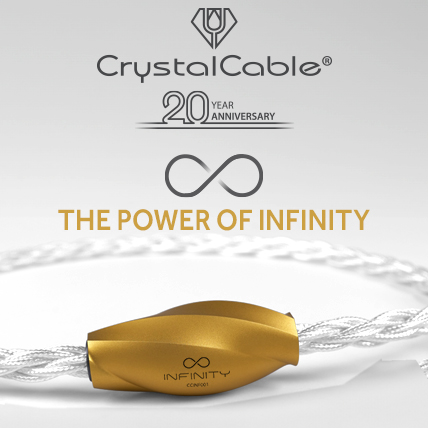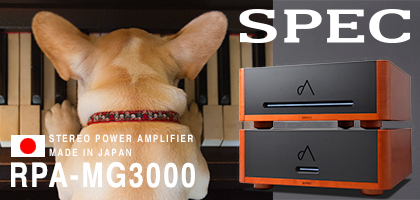No. 246 November 2024
- COVER REVIEW: Sforzato DSP-07EX ⸜ audio file player » JAPAN
- KRAKOW SONIC SOCIETY № 148: SILTECH MASTER CROWN » POLAND ⸜ Krakow
- REVIEW: Aura VA-40 REBIRTH ⸜ integrated amplifier » JAPAN
- REVIEW: Phonia GRAVIS 400 ⸜ loudspeakers • floor-standing » POLAND
- REVIEW: Stage III Concepts A.S.P. REFERENCE LEVIATHAN LIMITED EDITION ⸜ power cable AC » USA
- REVIEW: TiGLON MS-DR20R ⸜ analog interconnect RCA » JAPAN
- MUSIC ⸜ Our Albums Series: MILTON NASCIMENTO & ESPERANZA SPALDING, Milton + Esperanza, Concord Records UCCO-1243, SHM-CD ⸜ 2024 » USA / JAPAN
- MUSIC ⸜ Our Albums Series: HANG RAIJI Plus Five, Electric Bird/ Step Records STPR-044, UHQCD ⸜ 1983/2024 » JAPAN
- MUSIC ⸜review: JOHN LENNON, Mind Games (The Ultimate Mixes), Apple/Universal Music Group International, 2 x SHM-CD ⸜ 1973/2024 ˻ PL ˺

|
Editorial
text WOJCIECH PACUŁA |
 |
No 244 September 1, 2024 |
|
Design in audio. Or once more about the language
MY FAVOURITE IS NORI. I know, I shouldn't say it like that, all the charges of → USZATA PRZYSTAŃ are wonderful and everyone deserves love, but what can I do - Nori is the one I always visit first. You see, she's a rabbit girl who, after some bad experiences, ended up in the Kraków Stowarzyszenie Pomoc Królikom, where she is waiting to be adopted. I met her thanks to my daughter, a volunteer at the Przystań, whom I help by being her own volunteer in this way. When I first entered the pen of the black beauty the latter, as soon as she saw me, ran up and started tossing the scoop I was holding with her teeth. At first I was a little frightened when she charged at me like that, she is ultimately a big, beautiful rabbit with ears over twenty centimeters long, but it lasted only a blink of an eye. After a while I slipped her more things, which one by one she grabbed carefully in her teeth and tossed upwards. I thought it was just a game. 
⸜ „My” wonderful Nori in her pen The enlightenment came only two visits later when, in my drowsy mind, I managed to combine two facts: the tossing of objects and the envy-inducing unfettered joy of this ball of love from scratching behind the ears and under the throat. After several attempts, it became apparent that Nori tossing objects was demanding to be petted. She simply wanted attention in this way. I don't know how, I don't know where, or even how long she learned it, but I finally understood what she was saying to me: ‘please, pet me!’. As an excuse, I can say that the language in which rabbits communicate, both with each other and with their keepers, is not simple. The way cats or dogs communicate is quite clear to us because they have been present as our companions for thousands of years. It is the same with horses. We also understand something there, or at least those who had contact with the countryside when it was still a village, of the behaviour of large animals, but the smaller ones have never been an object of interest, only a food resource. Today we know that all living organisms feel, the vast majority of them have a so-called phenomenal consciousness and - it seems - all of them communicate, including plants. Communication occurs both at the species level and between species. However, to understand what they are saying, you need to know their language. Otherwise we will look at them with appreciation or not, with interest or not, but the interaction between us and them will be drastically reduced. And this is not an isolated case as language also co-creates other areas of human activity, with the arts in particular. We know, after all, that ballet has its own language, that theatre speaks in its own way, that we understand the way cinema speaks to us quite well. Let’s recall such a banal phrase as ‘this is a bizarre situation, atypical, maybe even related to an illness, sometimes to a mental illness’, evoked by the deflected shots of interiors, objects or characters. It will therefore come as no surprise if I say that architecture also has its language, as well as design. Also design in audio. Which is all the more interesting because the vast majority of manufacturers cannot speak their own language, and only copy the jargon of others without even knowing it. ‘Copy’ is the wrong word, by the way; a good copy is also a kind of work of art - it is more about unconscious imitation. More like duplication than creation. 
⸜ There's power! ESD's complete system called Super Dragon; presented at High End 2024 in Munich. And what do audio devices and products say to us? Well, they speak to us in different languages, and their makers want to achieve different goals by doing so. The most common phrase is ‘I am powerful’, sometimes turning into ‘I am the most powerful’. This is best seen using loudspeakers as an example. Let's recall the Divine Majestic model from the German company Göbel Audio, let's have a look at the equally - nomen omen - majestic Enigma Veyron 1D loudspeakers from the Dutch Kharma, let's have a look at the latest Italian Sonus Faber Suprema loudspeakers, and we will know what I am talking about. Their basic size is suffused by the drivers used in them - both their diameter and number. Then there are other acoustic requirements, such as the taper at the tweeter or the slope of the front panel. But how is it achieved, the execution of the features in question, it's all in the hands of the designer. And it is usually about a sense of dominance, to emphasize the so-called ‘pride of ownership’ and to make it clear who is boss in the house. The appearance of amplifiers is designed on a similar basis. Note the power of the 3000 series mono power amplifiers from the American manufacturer Boulder Amplifiers, each weighing 161 kg, the Nu-Vista PAM amplifiers from the British Musical Fidelity, which weigh almost 80 kg (apiece) including the power supply. In both cases, of course, it's all about high output, 6,000 watts in peak for Boulder and 1,500 for Musical respectively, requiring a powerful power supply. And that means oversized transformers and heat sinks. Which translates into massive size. But it is also the case that their appearance, or design, has been chosen so that it is clear ‘who is in charge’. Sizes are only the beginning, then there is how the product looks. And, I must say, I understand and accept it. Some systems require such amplifiers. On the one hand, there are loudspeakers whose current requirements are close to what a welder offers, and on the other, there are rooms where high SPL levels are impossible to achieve without a thousand watts per channel. And then there is the appearances - they are meant to make something of a ‘statement’, visible to anyone who enters a room. It can appeal at least to some. On the antipodes of this drive for grandiose, we find proposals that are by design delicate. Let me point out to, for example, the Japanese company 47 Laboratory and its beautiful, tiny CD players or amplifiers. Let me remind you the already classic Leben C300 amplifier and its contemporary incarnation, the → AURORASOUND HFSA-01 amplifier. Is it a coincidence that all three of these products, and I could add Shindo Laboratory amplifiers to them, and Fundamental’s, all come from Japan? The answer can only be one - no, it is not. And that is because these devices emanate a philosophy that says ‘less is more’, a philosophy of moderation and restraint. They say to us: ‘don't strain, just enjoy the music’. It can also be found in the products of European companies, such as the Model One from British Cyrus or, also from the UK, designs from the DNM company. We should also mention the company → CLONES AUDIO, now based in Taiwan, as well as the German Acoustic Plan. But these are rather exceptions, and the tendency to downsize, in its enormous diversity, is mainly Japanese audio’s thing. 
⸜ Aurrasound HFSA-01 integrated amplifier – a model of minimalism and functionality |
Does this mean that one proposal is better than the other? Interestingly, no. For it is not a question of being ‘big’ or ‘small’ per se, but of conformity of form to content. A problem as old as the world, ever since people started decorating everyday things. The point is that an audio product should be functional and attractive at the same time. Then even very large products will seem sensible. Recall Avalon loudspeakers and Soulution amplifiers, this is the type. Their design says: ‘we know what we are doing’ and “what we are doing makes sense”. Historically speaking, for a long time audio products were treated like just another piece of furniture - and that in the literal sense. A turntable, a radio with an amplifier and often loudspeakers were given enclosures that housed them all and could be closed like a door in a cupboard. The loudspeakers themselves had the form of a piece of furniture, which was emphasized by the wooden veneers and the material of the grilles. After liberation from this corset, there was a transitional period in which equipment from, for example, Marantz was sold with optional wooden cases designed to ‘domesticate’ them. What remains from those days are the wooden parts of the amplifier cases, usually the ‘side panels’. This, for example, is what Leben amplifiers look like nowadays, but also modern amplifiers with file players from Cambridge Audio's Evo series; test → HERE. In the 1970s, however, this changed. A generation proud of the ‘technicality’ of audio came to power, and the equipment, by now permanently, became likened to laboratory equipment. What had previously been used, but in a different context, became standard - a metal, design-treated front with knobs and bland other walls, which were to be hidden in specially prepared cabinets. And, of course, lights - as many lights as possible./p> Both of these solutions refer to the ‘times’ in which they were popular. The first option is the domestication of electronics and its taming. Nobody understood it, and what we don't understand - we fear. Furniture-like appliances and loudspeakers are thus a kind of security blanket, wrapping us up on a cold, rainy day. Technicization, on the other hand, aimed to convince users that they were participating in the triumphal march of technology, that they were part of it, and that the music played on such devices sounded ‘modern’, whatever that meant. 
⸜ The Western Electric WE 91E integrated amplifier is a good example of the retro trend, but with modern solutions More than fifty years have passed. It is astonishing, therefore, that during this time no further change has occurred, unless we consider the appearance of colour displays in file players to be one. It is as if the manufacturers had decided, with the tacit approval of the users, that the 1970s with its cult of technology of the time, enriched in the 1980s by the Japanese view of the subject, was the window of opportunity. These are products that say: ‘we are modern - you and me’. And yet that modernity is no longer our modernity, it is quite a distant past. As it turns out, this conservatism is inherent in audio. If something unusual appeared that crossed one of the ‘red lines’, be it ‘domesticated’ or ‘technicized’ equipment, it was treated with distrust. Examples? - Here you go: the Esoteric P-1 transport and the TAG McLaren DVD32 DVD/CD transport, the Nakamichi Dragon CD player, to stop just at digital, although I would add the Halcro amplifiers. How do we know that, while wonderful in their own right, they have not been given the green light? Well, it's because the design language they used didn't spread, no other company started to speak it. The situation is also similar with speakers. They are usually rectangular boxes, even if modified in the style of Focal, Wilson or Estelon. The recurring concept of loudspeakers in the form of a sphere has been more widely accepted in our industry only by the French Cabasse, while both Devialet with its magnificent Phantom model and Eclipse with TD-M1 have remained outside our ‘bubble’, finding their supporters in the mainstream of home equipment products and recording studios respectively. The same is true of planar speakers - they have their admirers, also in terms of design, and yet they are not as widely accepted as ordinary ‘boxes’. Today, we are dealing with all these approaches. There is a place for retromanically driven tube amplifiers straight out of the Western Electric catalogue from the 1930s, and futuristic products from KEF and the Muon loudspeakers, which are also very old. Time seems to have stood still in our industry and we are tossing and turning between these two extremes - the cosiness of retro style, a need stemming directly from the turbulent times in which we live, and the increasingly unattractive modernity, which, it turns out, promised much but delivered little. It seems, then, that in the middle of the 2nd decade of the 21st century, the audio world speaks many languages at once, some almost extinct, yet resurrected, and some new, though not taking into account the new words and expressions the world around us uses. The most important thing, therefore, is what I wrote about earlier: the form must be internally logical. That is to say, it must both serve and define the product, and that is the perfect fullness. This is when language becomes meaningful. This was understood, by the late Kenneth Grange, one of Britain's best-known industrial designers, in audio known for his design of the Bowers & Wilkins loudspeakers, the DM6, 801 and Matrix 800 models; the former was nicknamed the ‘pregnant penguin’, as well as Aura devices; more → HERE ˻PL˺. He was able to speak many languages at once in such a way that they were comprehensible, while at the same time requiring intellectual effort from his interlocutors. If you think design is agnostic, you are wrong. The visual design of products is political to the point of pain - political in the sense that it speaks for its creators and wants to force something on us, be it attention, be it approval, be it finally purchase. It's not that the design of audio equipment is ‘mute’. 
⸜ Any way you look at it, design in audio products stopped in the 1970s. Some companies, like Accuphase, have been faithful to it throughout their business, which makes sense I don't know if there are any fish keepers among you, current or former, but those who have had an aquarium know that fish have personalities, that they play, that they get attached to ‘their’ human. They can even learn from their mistakes and traumas. For years we have been convinced that fish feel nothing and have no higher feelings. This is because they have not developed the cerebral cortex, the part of the brain that is responsible for pain and other feelings in humans (and others). And yet birds don't have it either, although the general consensus is that many of them are extremely intelligent creatures, empathetic, cooperative with each other, etc. And besides, all these creatures speak. They talk to each other, they also address us. Fish are no exception. It's just that their language is almost opaque to ours, because we don't understand their movements, the colors of their scales, nor do we feel the chemicals they spray in the water. And these are all words and whole sentences. Let us therefore be attentive, also when choosing audio products. Let them ‘speak’ to us. Because the fact that they have their own language is already, I hope, clear. Let us choose those that speak to us beautifully, wisely and well. The ones that babble, impersonate others and sometimes even force things on us - let's reject them. The world of inanimate objects is full of stories, and they are worth listening to. Therefore, let us listen to those that can teach us something. ● WOJCIECH PACUŁA STOWARZYSZENIE POMOCY KRÓLIKOM (RABBIT RESCUE ASSOCIATION), that Uszata Przystań in Kraków is a member of, brings together people who want to be actively involved in widely understood help for rabbits. All members of the SPK work on a voluntary basis. It operates throughout the country, but mainly where its volunteers are, namely: Warsaw, Sopot, Krakow, Wroclaw and Rybnik. If you would like to find out more, support its activities (which we strongly encourage you to do), or perhaps even adopt a rabbit, please contact the Association directly: → KROLIKI.net. This year the SPK is celebrating its 20th anniversary - we wholeheartedly congratulate you and wish you all the best and good luck with the adoptions! ● |
About Us |
We cooperate |
Patrons |
|
Our reviewers regularly contribute to “Enjoy the Music.com”, “Positive-Feedback.com”, “HiFiStatement.net” and “Hi-Fi Choice & Home Cinema. Edycja Polska” . "High Fidelity" is a monthly magazine dedicated to high quality sound. It has been published since May 1st, 2004. Up until October 2008, the magazine was called "High Fidelity OnLine", but since November 2008 it has been registered under the new title. "High Fidelity" is an online magazine, i.e. it is only published on the web. For the last few years it has been published both in Polish and in English. Thanks to our English section, the magazine has now a worldwide reach - statistics show that we have readers from almost every country in the world. Once a year, we prepare a printed edition of one of reviews published online. This unique, limited collector's edition is given to the visitors of the Audio Show in Warsaw, Poland, held in November of each year. For years, "High Fidelity" has been cooperating with other audio magazines, including “Enjoy the Music.com” and “Positive-Feedback.com” in the U.S. and “HiFiStatement.net” in Germany. Our reviews have also been published by “6moons.com”. You can contact any of our contributors by clicking his email address on our CONTACT page. |
 



|
   |
main page | archive | contact | kts
© 2009 HighFidelity, design by PikselStudio,
projektowanie stron www: Indecity










